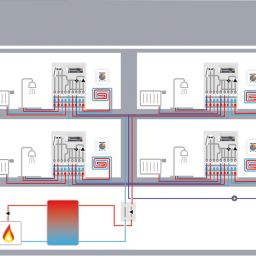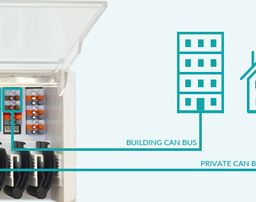The Requirements of Surface Cooling for the Control Technology
Reading time: 6 Min
Due to the high level of comfort and pleasant radiant heat, surface heating via floor, wall or ceiling is the most commonly used method of heat distribution in new buildings. The market share continues to grow steadily.
The area of room cooling is also on the upswing. An estimate of the European Commission assumes that the demand for air conditioning in buildings will increase by 70% in the EU by 2030. [i]
As further growth is already forecast for both markets individually, a great potential for the 2-in-1 system surface cooling can be derived. For this reason, the cooling application and intelligent implementation will become increasingly important for surface heating in the future.
The variants of room cooling
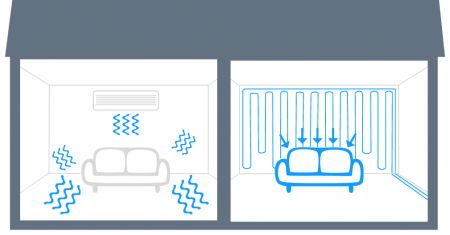
Two kinds of room cooling
| Classic Air Conditioning | Surface Cooling |
|---|---|
| Convection | Radiation |
| Cooling room air | Cooling the surfaces |
| Energy carrier air | Energy carrier water |
Pros and cons of the two variants
Both variants of room cooling clearly have different advantages and disadvantages.
1) The classic air conditioning system
+ Higher cooling capacities can generally be achieved
+ Faster temperature regulation possible
+ Some air conditioners can control not only the temperature but also the humidity
– Convection creates a draft that is often perceived as disturbing
– High operating costs
– Air conditioning is visible and audible
2) The surface cooling system:
+ 2-in-1 system: The surface heating infrastructure is shared
+ Energy savings & environmental friendliness: Due to the large cooling surface, a significantly lower temperature difference is sufficient. A low temperature level is optimal for the combination with regenerative energy sources. As a result, energy and CO2 savings of 50 to 90% are possible when cooling buildings [ii]
+ Radiation effect: For the same heat perception, the actual room air temperature can be up to 3°C higher with surface cooling than with classic air conditioning systems
+ Aesthetics: heat distribution in the room practically invisible
– Dew point problem: the room temperature cannot easily be reduced at will
Controlling a surface cooling system
Where the advantages of surface cooling are to be exploited, there are some additional requirements for the control system.
Firstly, the general control logic must be inverted for cooling operation. This is because in cooling mode a room should be supplied with cold water when the room is too warm, and not, as in heating mode, when it is too cold.
As with surface heating, multi-zone control is also useful for cooling applications for maximum comfort and efficiency. A room on the sunny south side may need to be cooled more than a shaded room on the north side of a house. In addition, in many cases not all rooms should be cooled. For example, cooling is often undesirable in the bathroom. The multi-zone control should therefore allow the user to enable cooling operation in individual zones.
It is also important that the changeover between heating and cooling takes place simultaneously in the entire heating system. To avoid different operating modes in the system, a control solution that communicates with the energy source, for example, is therefore recommended. If an invertible heat pump is used as the energy source, a simultaneous, central seasonal changeover is useful.
For efficient and demand-based operation, a demand for the energy source is also advantageous in cooling mode. Here too, the control system should be designed to convert the heating requirement into a cooling requirement.
The dew point problem
A particular challenge in surface cooling is the risk of dew formation.
Dew (condensed water) occurs when warm and humid room air meets cool components.
There are therefore 3 factors whose interaction is decisive for dew formation:
- room temperature
- air humidity
- surface temperature
The combination of these 3 parameters, from which dew formation can occur, is also called dew point.
In new, well-insulated buildings, less humidity can diffuse through the wall to the outside and high humidity is reached more quickly. In combination with the cold surface of the surface cooling, this can quickly become problematic. Especially if one also takes into account that a comparatively higher room temperature is comfortable due to the radiation of the surface cooling.
In order to prevent dew formation and the associated possibility of mould growth, various measures can be taken to detect and prevent it.

Dew point curve
Recognition of dew formation
The simplest possibility is to set the flow temperature not lower than 16°C during cooling. However, this is only a general approximation (25°C air + 58% relative humidity), problematic due to possible fluctuations in humidity and is by no means safe.
One option for detecting dew formation is to use a humidity sensor or humidity monitor. Here a humidity sensor is used, e.g. on a pipe, to detect when dew is forming. This is a reactive way of detecting when the temperature falls below the dew point after it has occurred.
A proactive and preventive way to detect when the dew point is about to be undershot is “dew point monitoring”.
The room temperature [°C] and the relative humidity [%] can be measured using room thermostats or room sensors. The temperature [°C] of the cold surface is also required. This can be measured by surface sensors, for example. Another possibility is to measure the flow temperature. This allows a “worst case” analysis to be carried out at a central point. This is because the cooled surface cannot become cooler than the cold water used for cooling.
With these sensor values, the controller can calculate the current position on the dew point curve (see figure dew point curve). This can be used as a preventative measure to check whether dew can form under the current conditions.
When combined with a multi-zone control system, dew point monitoring can be implemented room by room in addition to central measurement. For this purpose, the relative humidity is measured in each room in addition to the room temperature in order to calculate the position of the dew point for each room separately. In this way, different conditions within a residential unit can also be taken into account. (In rooms where people stay for a long time, the air humidity increases. A room on the sunny south side has a higher room temperature than a room on the shady north side).
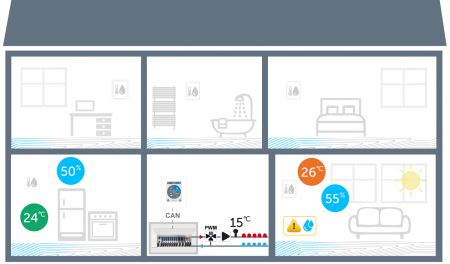
Dew point monitoring on room basis: different room conditions lead to different dew points
Handling dew formation
The detection of a temperature below the dew point alone does not of course prevent dew formation. The correct reaction to this is also important.
First of all, a structural measure to prevent dew formation can be taken by insulating the distributor and the connecting lines.
A reaction to reaching the dew point which can be implemented quite simply is to switch off the cooling system. This prevents damage to the room, but is accompanied by a loss of comfort for the occupant.
Instead, a “dew point correction” can also be carried out. In this case, the flow temperature is adjusted taking the dew point curve into account and cooling is only carried out as much as the current situation allows without dew formation. This option requires surface cooling to influence the flow temperature, e.g. via a mixer. However, this offers a great gain in comfort, as it ensures the most effective and safe cooling operation at all times.
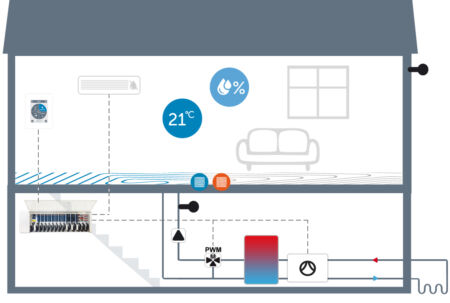
System example for a holistically controlled surface cooling
The formation of dew can also be avoided by influencing the humidity of the air. The principle is similar to the “dew point correction”, only a different factor of dew formation is influenced. For this purpose, a separate dehumidifier or fan is required for surface cooling. This solution can also be used preventively and without loss of comfort, but it requires an additional device with cost, space and installation requirements.
In addition: in order for a fan or dehumidifier to be actively used for preventing condensation, the control of the surface cooling system must be able to regulate it or influence the system.
Summary
It can be assumed that the importance of surface cooling will increase in the future. Surface cooling offers many advantages in terms of energy efficiency, environmental friendliness and comfort. However, it also places increased demands on the control system.
One hurdle on the road to success of surface cooling is the solution of the dew problem. Solutions for this already exist (dew point monitoring, dew point correction, dehumidifier), which enable mould-free and comfortable cooling operation. If these solutions are consistently implemented in practice, the advantages of surface cooling can be safely realised and the enormous potential offered by the growing market of surface cooling can be realised.
[i] https://www.erneuerbareenergien.de/nachhaltige-co2-freie-kaelte
[ii] https://www.zdf.de/nachrichten/heute/wie-klimafreundliche-kuehlung-aussehen-kann-100.html






